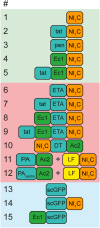A quantitative comparison of cytosolic delivery via different protein uptake systems
- PMID: 29038564
- PMCID: PMC5643320
- DOI: 10.1038/s41598-017-13469-y
A quantitative comparison of cytosolic delivery via different protein uptake systems
Abstract
Over many years, a variety of delivery systems have been investigated that have the capacity to shuttle macromolecular cargoes, especially proteins, into the cytosol. Due to the lack of an objective way to quantify cytosolic delivery, relative delivery efficiencies of the various transport systems have remained unclear. Here, we demonstrate the use of the biotin ligase assay for a quantitative comparison of protein transport to the cytosol via cell-penetrating peptides, supercharged proteins and bacterial toxins in four different cell lines. The data illustrate large differences in both the total cellular internalization, which denotes any intracellular location including endosomes, and in the cytosolic uptake of the transport systems, with little correlation between the two. Also, we found significant differences between the cell lines. In general, protein transport systems based on cell-penetrating peptides show a modest total uptake, and mostly do not deliver cargo to the cytosol. Systems based on bacterial toxins show a modest receptor-mediated internalization but an efficient delivery to the cytosol. Supercharged proteins, on the contrary, are not receptor-specific and lead to massive total internalization into endosomes, but only low amounts end up in the cytosol.
Conflict of interest statement
The authors declare that they have no competing interests.
Figures






Similar articles
-
A Biotin Ligase-Based Assay for the Quantification of the Cytosolic Delivery of Therapeutic Proteins.Methods Mol Biol. 2017;1575:223-236. doi: 10.1007/978-1-4939-6857-2_14. Methods Mol Biol. 2017. PMID: 28255884
-
CyLoP-1: a novel cysteine-rich cell-penetrating peptide for cytosolic delivery of cargoes.Bioconjug Chem. 2011 Mar 16;22(3):319-28. doi: 10.1021/bc100045s. Epub 2011 Feb 14. Bioconjug Chem. 2011. PMID: 21319732
-
Unlocking Endosomal Entrapment with Supercharged Arginine-Rich Peptides.Bioconjug Chem. 2017 Dec 20;28(12):2932-2941. doi: 10.1021/acs.bioconjchem.7b00560. Epub 2017 Nov 13. Bioconjug Chem. 2017. PMID: 29065262 Free PMC article.
-
Trapped! A Critical Evaluation of Methods for Measuring Total Cellular Uptake versus Cytosolic Localization.Bioconjug Chem. 2019 Apr 17;30(4):1006-1027. doi: 10.1021/acs.bioconjchem.9b00112. Epub 2019 Apr 5. Bioconjug Chem. 2019. PMID: 30882208 Free PMC article. Review.
-
Delivery into cells: lessons learned from plant and bacterial toxins.Gene Ther. 2005 Jun;12(11):865-72. doi: 10.1038/sj.gt.3302525. Gene Ther. 2005. PMID: 15815697 Review.
Cited by
-
A Computational Investigation of In Vivo Cytosolic Protein Delivery for Cancer Therapy.Pharmaceutics. 2021 Apr 15;13(4):562. doi: 10.3390/pharmaceutics13040562. Pharmaceutics. 2021. PMID: 33921165 Free PMC article.
-
Beyond canonical PROTAC: biological targeted protein degradation (bioTPD).Biomater Res. 2023 Jul 21;27(1):72. doi: 10.1186/s40824-023-00385-8. Biomater Res. 2023. PMID: 37480049 Free PMC article. Review.
-
Cytosolic Delivery of Functional Ubiquitin.J Pept Sci. 2025 Jun;31(6):e70026. doi: 10.1002/psc.70026. J Pept Sci. 2025. PMID: 40344378 Free PMC article.
-
Lethal Factor Domain-Mediated Delivery of Nurr1 Transcription Factor Enhances Tyrosine Hydroxylase Activity and Protects from Neurotoxin-Induced Degeneration of Dopaminergic Cells.Mol Neurobiol. 2019 May;56(5):3393-3403. doi: 10.1007/s12035-018-1311-6. Epub 2018 Aug 18. Mol Neurobiol. 2019. PMID: 30121937 Free PMC article.
-
Simultaneous measurement of p53:Mdm2 and p53:Mdm4 protein-protein interactions in whole cells using fluorescence labelled foci.Sci Rep. 2019 Nov 29;9(1):17933. doi: 10.1038/s41598-019-54123-z. Sci Rep. 2019. PMID: 31784573 Free PMC article.
References
Publication types
MeSH terms
Substances
LinkOut - more resources
Full Text Sources
Other Literature Sources

